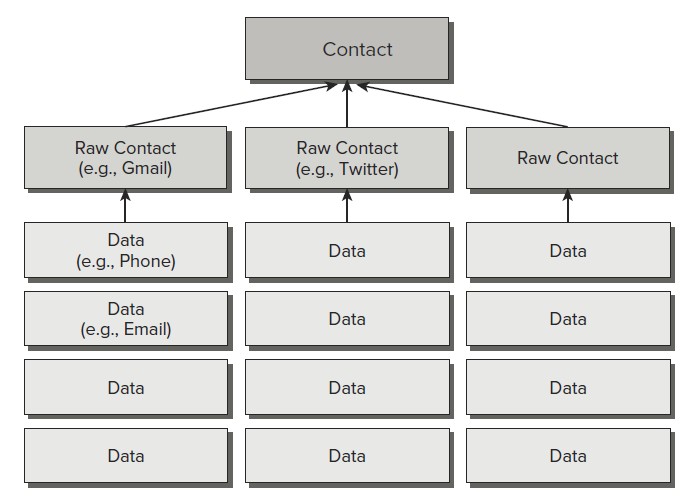参考《Professional Android 4 Development》
搜索
通过下面这几种方式可以给应用程序添加搜索功能:
- Search Bar

- Search View

- Quick Search Box

可搜索的Content Provider
首先,要在res./xml目录下创建一个xml文件,例如:
<?xml version=”1.0” encoding=”utf-8”?> <searchable xmlns:android=”http://schemas.android.com/apk/res/android” android:label=”@string/app_name” android:hint=”@string/search_hint”> </searchable>
其中,Label一般是应用程序的名称。
为应用程序创建Search Activity
Search Activity和普通的Activity不同,它是一直在back stack的栈顶,每次有新的search activity创建时,不会有将其简单的入栈,因为用户是不会希望按返回键时返回自己前面的查询结果。为了表明该Activity可以被搜索,需要将android.intent.action.SEARCH加入到自己的Intent Filter中,同时需要将前面创建的searchable的xml文件加到meta-data标签中:
<activity android:name=”.DatabaseSkeletonSearchActivity” android:label=”Element Search” android:launchMode=”singleTop”> <intent-filter> <action android:name=”android.intent.action.SEARCH” /> <category android:name=”android.intent.category.DEFAULT” /> </intent-filter> <meta-data android:name=”android.app.searchable” android:resource=”@xml/searchable” /> </activity>
用户进行搜索后,可以在搜索结果中继续搜索,而这种操作会生成新的Intent,而这些Intent可以通过onNewIntent handler来处理:
@Override public void onCreate(Bundle savedInstanceState) { super.onCreate(savedInstanceState); // Get the launch Intent parseIntent(getIntent()); } @Override protected void onNewIntent(Intent intent) { super.onNewIntent(intent); parseIntent(getIntent()); } private void parseIntent(Intent intent) { // If the Activity was started to service a Search request, extract the search query. if (Intent.ACTION_SEARCH.equals(intent.getAction())) { String searchQuery = intent.getStringExtra(SearchManager.QUERY); // Perform the search performSearch(searchQuery); } }
设置默认的Serach Provider
在应用程序中,最好设置一个Activity,让所有的搜索结果都从这个Activity中出来,设置方法也简单,将下面的配置加到程序配置中就可以了:
<meta-data android:name=”android.app.default_searchable” android:value=”.DatabaseSkeletonSearchActivity” />
使用Cursor Loader的Search Activity示例
import android.app.ListActivity; import android.app.LoaderManager; import android.app.SearchManager; import android.content.ContentUris; import android.content.CursorLoader; import android.content.Intent; import android.content.Loader; import android.database.Cursor; import android.net.Uri; import android.os.Bundle; import android.view.View; import android.widget.ListView; import android.widget.SimpleCursorAdapter; public class DatabaseSkeletonSearchActivity extends ListActivity implements LoaderManager.LoaderCallbacks<Cursor> { private static String QUERY_EXTRA_KEY = “QUERY_EXTRA_KEY”; private SimpleCursorAdapter adapter; @Override public void onCreate(Bundle savedInstanceState) { super.onCreate(savedInstanceState); // Create a new adapter and bind it to the List View adapter = new SimpleCursorAdapter(this, android.R.layout.simple_list_item_1, null, new String[] { MyContentProvider.KEY_COLUMN_1_NAME }, new int[] { android.R.id.text1 }, 0); setListAdapter(adapter); // Initiate the Cursor Loader getLoaderManager().initLoader(0, null, this); // Get the launch Intent parseIntent(getIntent()); } @Override protected void onNewIntent(Intent intent) { super.onNewIntent(intent); parseIntent(getIntent()); } private void parseIntent(Intent intent) { // If the Activity was started to service a Search request, extract the search query. if (Intent.ACTION_SEARCH.equals(intent.getAction())) { String searchQuery = intent.getStringExtra(SearchManager.QUERY); // Perform the search performSearch(searchQuery); } } // Execute the search. private void performSearch(String query) { // Pass the search query as an argument to the Cursor Loader Bundle args = new Bundle(); args.putString(QUERY_EXTRA_KEY, query); // Restart the Cursor Loader to execute the new query. getLoaderManager().restartLoader(0, args, this); } public Loader<Cursor> onCreateLoader(int id, Bundle args) { String query = “0”; // Extract the search query from the arguments. if (args != null) query = args.getString(QUERY_EXTRA_KEY); // Construct the new query in the form of a Cursor Loader. String[] projection = {MyContentProvider.KEY_ID, MyContentProvider.KEY_COLUMN_1_NAME}; String where = MyContentProvider.KEY_COLUMN_1_NAME + “ LIKE ”%” + query + “%””; String[] whereArgs = null; String sortOrder = MyContentProvider.KEY_COLUMN_1_NAME + “ COLLATE LOCALIZED ASC”; // Create the new Cursor loader. return new CursorLoader(this, MyContentProvider.CONTENT_URI, projection, where, whereArgs, sortOrder); } public void onLoadFinished(Loader<Cursor> loader, Cursor cursor) { // Replace the result Cursor displayed by the Cursor Adapter with the new result set. adapter.swapCursor(cursor); } public void onLoaderReset(Loader<Cursor> loader) { // Remove the existing result Cursor from the List Adapter. adapter.swapCursor(null); } }
大部分情况下,我们需要响应对搜索结果的click事件,因此需要重写onListItemClick方法:
@Override protected void onListItemClick(ListView listView, View view, int position, long id) { super.onListItemClick(listView, view, position, id); // Create a URI to the selected item. Uri selectedUri = ContentUris.withAppendedId(MyContentProvider.CONTENT_URI, id); // Create an Intent to view the selected item. Intent intent = new Intent(Intent.ACTION_VIEW); intent.setData(selectedUri); // Start an Activity to view the selected item. startActivity(intent); }
使用Search View Widget
Android 3.0后推出了Search View Widget以替代Search Activity。将Search View绑定到searchable activity中,首先要获取searchableInfo:
// Use the Search Manager to find the SearchableInfo related to this Activity. SearchManager searchManager = (SearchManager)getSystemService(Context.SEARCH_SERVICE); SearchableInfo searchableInfo = searchManager.getSearchableInfo(getComponentName()); // Bind the Activity’s SearchableInfo to the Search View SearchView searchView = (SearchView)findViewById(R.id.searchView); searchView.setSearchableInfo(searchableInfo);
本地Android Content Provider
Android中提供了一些本地的Content Provider,包括下面这些:
- Media Store
- Browser
- Contacts Contract
- Calendar
- Call Log
使用Media Store Content Provider
MediaStore类有Audio,Video和Image子类,这些子类又有含有uri信息的子类。每个子类中uri信息是这么存储的:
- MediaStore.<mediatype>.Media.EXTERNAL_CONTENT_URI
- MediaStore.<mediatype>.Media.INTERNAL_CONTENT_URI
下面是一个示例:
// Get a Cursor over every piece of audio on the external volume, // extracting the song title and album name. String[] projection = new String[] { MediaStore.Audio.AudioColumns.ALBUM, MediaStore.Audio.AudioColumns.TITLE }; Uri contentUri = MediaStore.Audio.Media.EXTERNAL_CONTENT_URI; Cursor cursor = getContentResolver().query(contentUri, projection, null, null, null); // Get the index of the columns we need. int albumIdx = cursor.getColumnIndexOrThrow(MediaStore.Audio.AudioColumns.ALBUM); int titleIdx = cursor.getColumnIndexOrThrow(MediaStore.Audio.AudioColumns.TITLE); // Create an array to store the result set. String[] result = new String[cursor.getCount()]; // Iterate over the Cursor, extracting each album name and song title. while (cursor.moveToNext()) { // Extract the song title. String title = cursor.getString(titleIdx); // Extract the album name. String album = cursor.getString(albumIdx); result[cursor.getPosition()] = title + “ (“ + album + “)”; } // Close the Cursor. cursor.close();
使用Contacts Contract Content Provider
Contacts Contract Provider使用三层模型存储数据:
